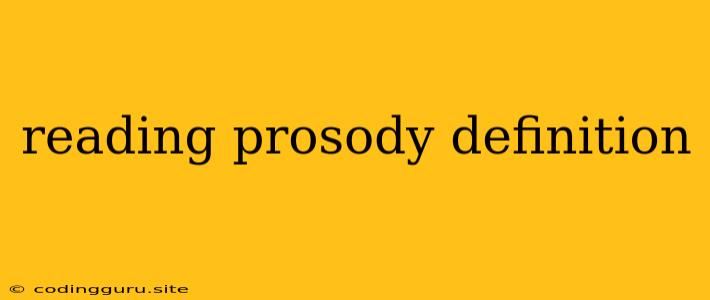What is Reading Prosody? Unlocking the Magic of Expressive Reading
Reading prosody, sometimes called "expressive reading," is the rhythm, intonation, and phrasing we use when reading aloud. It's the difference between a robotic recitation of words and a captivating performance that brings the text to life. Think of it as the soundtrack to your reading, adding emotion, meaning, and personality to the words on the page.
Why is reading prosody important?
- Improved Comprehension: Reading with prosody helps readers understand the meaning and intent behind the text. For example, pausing at commas and changing your pitch for questions helps differentiate between statements and inquiries.
- Enhanced Engagement: When reading aloud with prosody, listeners are more likely to stay engaged and attentive. This is especially crucial for younger readers who are still developing their reading skills.
- Increased Confidence: Reading expressively boosts confidence and self-esteem in young readers. When they feel comfortable and fluent with the text, they are more likely to participate in reading activities.
- Development of Fluency: Prosody plays a key role in fluency. By reading with correct intonation and pacing, readers gain confidence and accuracy in reading.
Key Components of Reading Prosody:
1. Intonation: Intonation refers to the rise and fall of your voice. It helps convey emotions and differentiate between statements, questions, and exclamations. Think of how you would change your voice when asking a question compared to making a statement.
2. Pitch: Pitch refers to the highness or lowness of your voice. Like intonation, pitch can convey emotion and emphasis. For example, you might use a higher pitch to express excitement or surprise.
3. Stress: Stress refers to the emphasis you place on certain words or syllables. It helps highlight important words and phrases within a sentence.
4. Pause: Pauses are important for clarity and understanding. They allow the reader to breathe, for the listener to process the information, and for the reader to emphasize important points.
5. Pace: Pace refers to the speed at which you read. A slower pace can be used for emphasis or to create a dramatic effect, while a faster pace can be used to convey excitement or urgency.
Developing Reading Prosody:
1. Model Expressive Reading: Children learn by observing and imitating. Read aloud with a variety of voices and emotions, emphasizing different aspects of prosody. 2. Engage in Interactive Reading: Use shared reading activities where you read with children, taking turns reading sentences or paragraphs. This allows them to practice reading with prosody and receive feedback. 3. Use Props and Visuals: Props and visuals can help children visualize the story and understand the meaning of the text, which in turn helps them read with more expression. 4. Practice with Familiar Texts: Start with texts that children are familiar with and comfortable reading. This will help them focus on improving their prosody without feeling overwhelmed. 5. Provide Feedback: Offer specific and positive feedback on children's reading. Focus on one or two aspects of prosody at a time, such as intonation or pace.
Tips for Improving Reading Prosody:
- Read aloud to yourself: Practice reading with prosody before reading aloud to others.
- Record yourself: Listen to your recording and identify areas where you can improve your intonation, pace, or stress.
- Use a mirror: Observing your facial expressions and body language can help you become more aware of your prosody.
- Practice with different texts: Try reading aloud from different genres, such as poetry, fiction, and nonfiction.
- Join a reading group: Reading with others can provide support and feedback.
Conclusion:
Reading prosody is a vital skill that enhances comprehension, engagement, and fluency. By developing and practicing prosody, readers can unlock the magic of expressive reading and truly bring the text to life.
